How a stray cat changed a man into a human being
by William Jordan
 This book caught my attention as a loaner from a special lady friend via my mom, both cat lovers. I thought it would make a nice change of pace from works on political morality or economy, and I was right.
This book caught my attention as a loaner from a special lady friend via my mom, both cat lovers. I thought it would make a nice change of pace from works on political morality or economy, and I was right.
Like the author, Bill Jordan, I have a long history of relative disconnection from animal planet, whether the wide variety of wild fauna or domesticated pets. (My dear late brother Forrest was the true animal lover in the family; he possessed a rare sensitivity to all living things. He provided the family with the impetus to acquire dogs, cats, goldfish, and so on, and the inclination to care for them.)
Forrest was particularly fond of dogs and had show-worthy Shelties since our teens. On the other hand, to the extent I had pets later on, my preference was cats: During college in Detroit I had a large full-furred, golden tom named Samson. Then when I married, we received a farm cat from a friend and named it ever so imaginatively “Critter;” she was a wonderful and beautiful addition.
While my wife was particularly in tune with Critter, I never took the time in either of my major adult cases of pet/cat ownership to connect deeply. I was friendly but uncommitted, never considering letting down any barriers of species chauvinism—indeed, my overwrought Randian persona would have ridiculed any notion of other-species sensitivity at the time
The author of A Cat Named Darwin, a biologist by training, finds himself in the nonconventional-family situation of living alone in his 40s in Long Beach, California, making a go as a writer. He encounters a stray cat that seems to glom on to him as more than just a meal ticket. (In their first encounter, the cat actually comes up to the stooping Jordan and places a front paw on the man’s nose.)
The remainder of the book is about the rise and fall of a unique cross-species relationship that leaves the man saddened by the cat’s (prolonged) demise yet enriched by the love this kind of special relationship can bring. In the course of the relationship, the author reflects movingly on its several facets.
The noted psychologist of self-esteem, Nathaniel Branden, wrote an article in his book The Psychology of Romantic Love about something he called the “Muttnik Principle.” Dr. Branden had a dog named Muttnik. He noted when they played, even roughly, Muttnik seemed to sense immediately it was play and not anything hostile.
Branden used this observation to develop a theory of psychological visibility: more or less that we like other consciousnesses—human or not—that “see us” as we want to be seen. If Muttnik recoiled from extension of Branden’s arm, that would be pathological. If someone we greet with Good Morning reacts with Up Yours, we know something is wrong.
Healthy psychology is open, friendly, benevolent, even playful, psychology… and we need to cultivate it. Pets are a natural source. A corollary of Muttnik is that a life-affirming benefit accrues when we are perceived appropriately by another awareness. We are mainly aware of ourselves abstractly; a pet or a loved one is aware of us as a percept, i.e. a concrete object. This concretized affirmation of our own existence, that we are and ought to be, helps keep us going.
So Darwin provides to the author a rare affirmation, and the author captures it well.
A cat provides a different sort of affirmation from a dog. I specifically appreciate what Jordan has to say regarding the differences of affection and psychology between dogs and cats:
“A relationship with dogs, far more than with cats, is based on subordination, not equality. It is a master/subject relationship, and there is no helping it. The dog will not have it any other way. Its mind has been calibrated to exist within the structure of a pack… The dog depends for survival on its ability to adjust to the moods and needs of its pack mates, and is highly sensitive to them….
“The cat, however, is an interesting case because its basic nature is solitary, yet it too fits the human mind… The cat in nature has little need to express itself, particularly in facial gestures, for it has no one to face and no one to communicate with. That is why the cat simply stares and stares at its human benefactor…. And that is why it finds a home in the human mind: the cat relieves the solitude of the self… The cat is a kindred spirit to the private, ruminating side of our mind, and it slips unobtrusively in and out of our solitude at will.”
These passages help me understand the often fanatical hatred and disturbing cruelty, mainly by men—my experience is such men don’t like (psychologically independent) women very much either—directed toward cats. Cat lovers express nothing like this sort of irrational hostility toward dogs: how does one detest such a simple program? Even though cats and even ourselves, arguably, also conform to a program, the logical purity and sophistication of its subroutines seem to scratch at the heavens. [1]
Anyway, good little read, even for dog lovers.
[1] One thing Jordan fails to note in the consideration of cats in general is something that completely astounds and awes me: the unparalleled athleticism of cats. I’ve seen a cat perform a standing jump to a curved-surfaced, two-inch wooden railing running four feet above its head, then walk to the start of the railing, turn around and walk back! (To one side of the end of the railing is the bottom of a stairwell 12-15 feet below.) Amazing.
This post has been read 2279 times!


